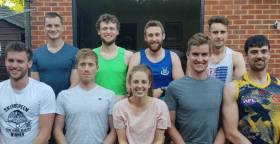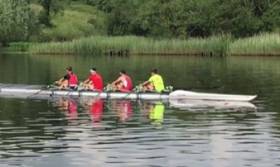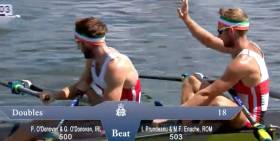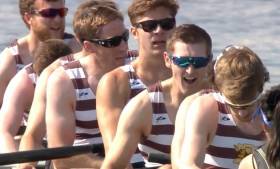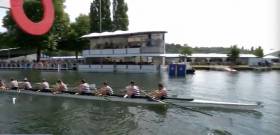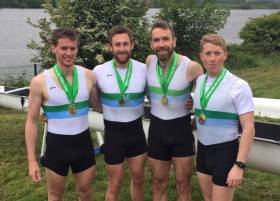Displaying items by tag: Henley Royal Regatta
Commercial in Command in Heat of Thames Cup at Henley
#Rowing: Commercial moved efficiently through their first outing at Henley Royal Regatta today. The Thames Cup club eight beat Nottingham Rowing Club with little fuss. The Dublin club crew led by a length after half a mile, then established a clearwater lead which they held to the finish line.
Henley Royal Regatta – Day One (Irish interest)
Thames Cup (Men’s Eights, Club): Commercial bt Nottingham RC
Good Results for Irish Rowers at Henley Qualifiers
#Rowing: A good selection of Irish crews made it through the Qualifiers for Henley Royal Regatta on Friday – a number of them in the difficult ‘open’ events.
In the Hambleden Pairs – an open event – Natalie Long of Skibbereen and Sadhbh O’Connor of NUIG came through, as did Orla Hayes in the Princess Royal Cup, the open category in women’s single sculls.
Enniskillen’s boys’ quadruple made in through in the Fawley, and their girls’ quadruple matched them in the Diamond Jubillee.
The UCD women’s eight did not make it through in the Remenham, an open event, but Nathan Hull of Queen’s and Ollie Dix of Leander qualified in the Double Sculls.
Henley Royal Regatta, Qualifiers, Friday (Irish interest)
Remenham Cup (Women’s Eights, Open): UCD did not qualify
Prince of Wales (Men’s Quadruple, Club and University): Lagan Scullers’ did not qualify
Fawley (Men’s Quadruple, Junior): Enniskillen Royal Boat Club Qualified
Diamond Jubilee Cup (Women’s Quadruple, Junior): Enniskillen Royal Boat Club Qualified
Britannia (Men’s Fours, coxed, Club): Belfast Rowing Club did not qualify
Hambleden Pairs (Women’s Pairs, Open): Sadhbh O’Connor and Natalie Long (NUIG and Skibbereen) Qualified
Double Sculls (Men’s Double, Open): Nathan Hull and OJ Dix (Queen’s, Belfast and Leander) Qualified
Princess Royal (Women’s Single, Open): Orla Hayes (Skibbereen) Qualified
O'Driscoll and O'Donovan to Compete at Henley Royal Regatta
#Rowing: The standout names in the Irish entry for Henley Royal Regatta are Mark O’Donovan and Shane O’Driscoll. The world lightweight champions of 2017 have entered the Silver Goblets for open pairs.
The Irish challenge features Commercial in the Thames Cup for club eights and UCD’s four in the Visitors. Both crews are Irish champions. Enniskillen have chosen to enter quadruples in the Fawley and the Diamond Jubilee.
UCD, who compete at Henley Women’s Regatta this weekend, have entered the open event for women’s eights, the Remenham. Orla Hayes of Skibbereen has entered the Princess Royal, the open event for women's single scullers.
Henley Royal Regatta, July 3rd to 7th (Selection of Entries, Irish interest)
Remenham Cup (Women’s Eights, Open): UCD
Thames (Men’s Eight, Club): Commercial
Visitors (Men’s Four, Club and University): UCD
Prince of Wales (Men’s Quadruple, Club and University): Lagan Scullers’
Fawley (Men’s Quadruple, Junior): Enniskillen Royal Boat Club
Diamond Jubilee Cup (Women’s Quadruple, Junior): Enniskillen Royal Boat Club
Britannia (Men’s Fours, coxed, Club): Belfast Rowing Club
Silver Goblets (Men’s Pairs, Open): Mark O’Donovan and Shane O’Driscoll (Skibbereen)
Hambleden Pairs (Women’s Pairs, Open): Sadhbh O’Connor and Natalie Long (NUIG and Skibbereen)
Double Sculls (Men’s Double, Open): Nathan Hull and OJ Dix (Queen’s, Belfast and Leander)
Stonor Trophy (Women’s Double Sculls, Open): Fiona Chestnutt, CK Knight (Reading Univ and Newcastle Univ)
Diamond Sculls (Men’s Single, Open): Callum McCrae (Cambridge Univ Lightweight RC)
Princess Royal (Women’s Single, Open): Orla Hayes (Skibbereen)
#Rowing: Paul and Gary O’Donovan were beaten in the final of the Double Sculls Challenge Cup by Jack Beaumont and Angus Groom at Henley Royal Regatta today. The Skibbereen men blasted off the start, but the Britain heavyweight crew took an early lead. The O’Donovans came back at them but their steering was problematic and the umpire had to twice redirect them. Groom and Beaumont, rowing off the more favoured Berkshire station, went on to win by five lengths.
Henley Royal Regatta (Selected Results; Irish interest)
Double Sculls Challenge Cup (Open) – Final: A Groom, J Beaumont bt G O’Donovan, P O’Donovan 5l.
#Rowing: Paul and Gary O’Donovan won their semi-final of the Double Sculls at Henley today. The Romanian heavyweight crew of Ioan Prundeanu and Marian-Florian Enache matched the Skibbereen men in the first quarter. The race was effectively over soon after, as the Olympic lightweight silver medallists moved into a clear lead and stretched it to over four lengths. The Irish crew, wearing tricolour headbands, were cheered loudly as they passed the enclosures.
Henley Royal Regatta, Day Four (Irish interest; selected results)
Double Sculls (Open) Semi-Final: J Beaumont, A Groom bt K Brun, A Strandli ¾ l; G O’Donovan, P O’Donovan bt I Prundeanu, M-F Enache 2¼ l.
American Crews Oust Cork and NUIG From Henley
#Rowing: Cork Boat Club raced well but made their exit to New Jersey crew Montclare Mounties in the Thames Cup at Henley Royal Regatta. The Americans started powerfully and took an early one-length lead. Cork stayed calm and bit chunks out of the lead as the crews entered the enclosures area. Montclare would not yield: they finished well and won by three-quarters of a length.
NUIG secured an early lead and held it until the final stages of their race in the Prince Albert for student coxed fours. Columbia University then swept past and won by one and three-quarter lengths.
Yale, with Daire Lynch in the three seat, beat Princeton in a thrilling race in the Temple Cup. Princeton, who had trailed, darted to the line and came within a canvas of winning.
Henley Royal Regatta, Day Three (Irish interest; selected results)
Temple Cup (Eights, College): Yale (3 D Lynch) bt Princeton, canvas.
Thames Cup (Eights, club): Montclair Mounties, United States bt Cork Boat Club ¾l .
Prince Albert (Fours, coxed; Student): Columbia University, US bt NUIG 1¾ l.
Double Sculls (Open): G O’Donovan, P O’Donovan bt S Cox, T Oliver 4¾ l.
Cork March On at Henley Rowing Regatta
#Rowing: Cork Rowing Club moved smoothly into the second round of the Thames Cup at Henley Royal Regatta with a straightforward win this morning. They took an early lead over London Rowing Club ‘A’, and extended it to one length by half way. They stayed in their rhythm and a push by their opponents made little difference; they went on to establish a clearwater lead by the enclosures.
In the Double Sculls Challenge Cup, Tiernan Oliver, rowing with Leander for the summer, teamed up with Stephen Cox to win their heat. They will meet Paul O’Donovan and Gary O’Donovan tomorrow.
Henley Royal Regatta, Day Two (Selected Results; Irish interest)
Thames Cup (Eights, Club): Cork Boat Club bt London RC ‘A’ 1 ¾ l.
Double Sculls (Open): S Cox, T Oliver bt JJP Keech and JA Dunley 1 ¼ l.
Cork Boat Club Look Strong at Henley Royal Regatta
#Rowing: Cork Boat Club continued the winning run by Irish crews on the first day of Henley Royal Regatta. They beat Potomac of the United States by three-quarters of a length in the Thames Cup for club eights. The race was unusual in that Cork made a fine start but were passed by Potomac, who looked like they might take control of the race. Cork’s comeback was impressive: they cut down the lead and then passed Potomac. The Irish took charge and stayed in the lead to the end.
Earlier, Neptune had won their heat of the Fawley Cup for junior quadruples.
Henley Royal Regatta, Day One (Selected Results; Irish interest)
Thames Cup (Eights, Club): Cork Boat Club bt Potomac, United States ¾ l, 6 min 35 sec.
Fawley (Quadruple, Junior): Neptune bt Tideway Scullers’ School ‘C’ 2/3l, 7:04.
Facile Win for Commercial in Second Round at Henley
#Rowing: Commercial won again at Henley Royal Regatta today. Their Wyfold club four beat Curlew with plenty to spare to progress to Friday’s competition. The London crew veered markedly towards Commercial at the start, and Commercial also crabbed to their right. Commercial then took control and were able to paddle home past the Enclosures and still win by four and a quarter lengths.
Henley Royal Regatta, Day Two (Irish interest)
Diamond Sculls (Open Single Sculls): J Stimpson bt N Kenny 3¼ l.
Temple Cup (College Eights): University of California, Berkeley bt Trinity 2½ l.
Wyfold (Club Fours): Commercial bt Curlew 4 ¼ l.
Kenny Bows to Bigger Opponent at Henley Regatta
#Rowing: Niall Kenny lost out in the first round of the Diamond Sculls to a much heavier opponent at Henley Royal Regatta today. Kenny (28) won a silver medal at the World Under-23 Championships in 2010 as part of the Ireland lightweight quadruple, but at 75 kg here he had a disadvantage of 23 kilogrammes against Jonathan Stimpson. The Briton powered into an early lead and won well.


























